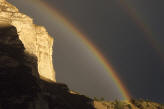|
|
Crater Lake is widely known
for its intense blue color and spectacular views. During summer, visitors
may navigate the Rim Drive around the lake, enjoy boat tours on the lake
surface, stay in the historic Crater Lake Lodge, camp at Mazama Village,
or hike some of the park's various trails including Mt. Scott at 8,929 ft.
Diverse interpretive programs enhance visitors' knowledge and appreciation
of this national park, 90% of which is managed as wilderness. The winter
brings some of the heaviest snowfall in the country, averaging 533 inches
per year. Although park facilities mostly close for this snowy season,
visitors may view the lake during fair weather, enjoy cross-country
skiing, and participate in weekend snowshoe hikes.
Few places on earth command overwhelming awe from
observers, but Crater Lake, in south central Oregon, certainly does. Even
in a region of volcanic wonders, Crater Lake can only be described in
superlatives. Stories of the deep blue lake can never prepare visitors for
their first breathtaking look from the brink of this 6 mile wide caldera
which was created by the eruption and collapse of Mt. Mazama almost 7,000
years ago. Even seasoned travelers gasp at the twenty-mile circle of
cliffs, tinted in subtle shades and fringed with hemlock, fir, and pine:
all this in a lake of indescribable blue.
Today, the nation's fifth oldest national park
serves to stand as a memorial to time. In 1902, Congress decided that
Crater Lake and its surrounding 180,000 acres were to be "dedicated and
set apart forever as a public park or pleasure ground for the benefit and
enjoyment of the people of the United States." The passing of this
legislative act had been a 17 year effort, championed by Crater Lake's
primary promoter, William G. Steel. The act (16 USC 121) also required
that measures be taken for the "preservation of the natural objects....the
protection of the timber....the preservation of all kinds of game and
fish," and as well as for use by "scientists, excursionists, and pleasure
seekers."
Crater Lake National Park is host to a diverse
array of activities. While enjoying the natural scenic wonders, park
visitors may hike in old growth forests, participate in a variety of
interpretive activites, camp out or stay in an historic hotel, or even
cross-country ski during the eight month long winters which are
experienced here in the high Cascades.
Preserving this environment for the continued use
and enjoyment of the public is also a major goal of the National Park
Service. Resource managers are invloved in studies on lake ecology, forest
ecosystems, geologic processes, even the role of fire in maintaining
healthy relationships between the forests and the land. Their work yields
valuable data on the natural systems which have created and maintained
that which we fondly call Crater Lake National Park.
Crater Lake National Park has been recommended as
a wilderness preserve, a place where we may forget ourselves for a time
and enjoy a surge of healthy outdoor exploration. Here, we may rediscover
ourselves and learn that material things do not necessarily constitute our
richest possessions. This blue gem of the Cascades certainly moves us
deeply when we imagine the awesome power which created this wonderful
place.
|

